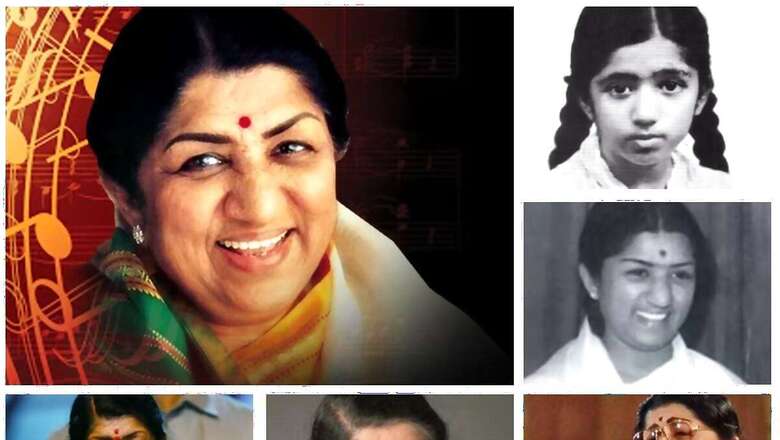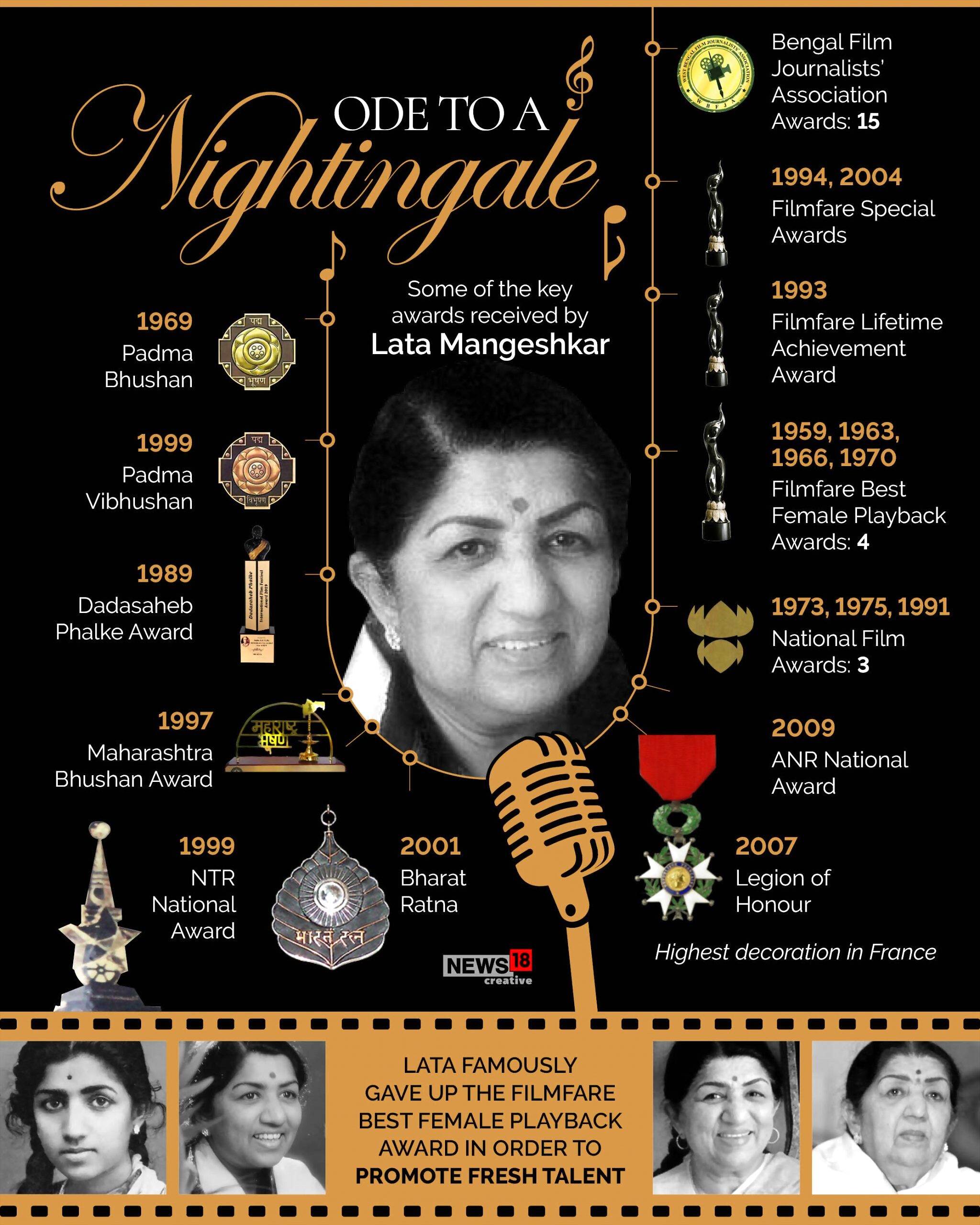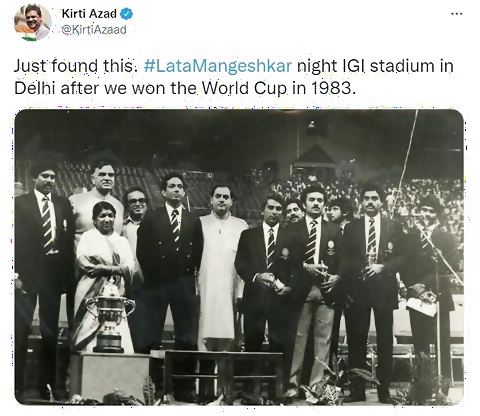
views
LATA MANGESHKAR 94TH BIRTH ANNIVERSARY: Lata Mangeshkar, the Nightingale of India, began her singing career at a young age, and quickly rose to prominence as one of the most sought-after playback singers in Bollywood. She was a legendary singer who recorded over 25,000 songs in 20 Indian languages. Her voice was versatile and expressive, and she could sing in a wide range of genres, from classical to folk to popular music. Her legacy continues to inspire and entertain people all over the world. On her 94th birth anniversary, we pay our respects to this legendary singer, and thank her for the gift of her music.

PM MODI REMEMBERS ‘LATA DIDI’
Prime Minister Narendra Modi led the nation in remembering Lata Mangeshkar on her birth anniversary. “Remembering Lata Didi on her birth anniversary. Her contribution to Indian music spans decades, creating an everlasting impact. Her soulful renditions evoked deep emotions and will forever hold a special place in our culture,” PM Modi posted on X, formerly Twitter.
Remembering Lata Didi on her birth anniversary. Her contribution to Indian music spans decades, creating an everlasting impact. Her soulful renditions evoked deep emotions and will forever hold a special place in our culture.— Narendra Modi (@narendramodi) September 28, 2023
THE EARLY LIFE OF LATA MANGESHKAR
Born in 1929: The Musical Prodigy Emerges
Lata Mangeshkar, originally named Hema Mangeshkar, was born in the city of Indore in 1929. Her prodigious musical talent became evident from a very young age. Despite her soft-spoken and reclusive nature, she possessed one of the most versatile voices during the golden era of Hindi cinema.
THE JOURNEY BEGINS: DEBUT AND MENTORSHIP
Debut at 13: Lata Mangeshkar made her singing debut at the tender age of 13 with the Marathi film “Pahili Mangalaa-gaur.” Interestingly, she also appeared in a brief role in the same film, which was produced by Navyug Chitrapat movie company. This production house was owned by a close family friend, the renowned actor-director Vinayak Damodar Karnataki, better known as Master Vinayak.
Guiding Light: Master Vinayak played a pivotal role in introducing Lata to classical music when she was around 16 years old. However, after his demise in 1948, another significant figure entered her life — music director Ghulam Haider.
The Mentorship: Lata Mangeshkar’s relationship with Ghulam Haider transcended the typical singer-composer dynamic. He discovered her as a teenager, nurtured her talent, and introduced her soulful voice to the world. In an interview on her 84th birthday, Mangeshkar acknowledged Haider’s role in providing her first major breakthrough with the song “Dil Mera Toda, Mujhe Kahin Ka Na Chhora” in the 1948 film “Majboor.”
THE SOARING CAREER: ICONIC SONGS AND COLLABORATIONS
Aayega Aana Waala: Lata Mangeshkar’s position as a playback singer was solidified with the song “Aayega aana waala” from the film “Mahal” in 1949. This marked the beginning of the most successful chapter of her career.
IN PICS: A Timeline of Queen of Melody’s Glorious Career
Collaborations Galore: Throughout the 1950s and 60s, she lent her melodious voice to various musical genres, from devotional bhajans like “Tumhi ho mata pita tumhi ho” to dance numbers like “Jabse Laagi Tose Najariya” and romantic tunes like “Lag Jaa Gale.”
Her patriotic track “Aye Mere Watan Ke Logo” from 1963, composed to commemorate Indian soldiers who perished during the Sino-Indian War, remains an iconic masterpiece.
The Kishore Kumar Era: Some of her most unforgettable classics emerged from her collaboration with Kishore Kumar, resulting in timeless duets such as “Kora Kagaz,” “Tere Bina Zindagi Se,” “Tere Mere Milan Ki,” “Aap Ki Ankhon Me Kuch,” and “Dekha Ek Khwab.”
A Versatile Collaborator: Lata Mangeshkar also partnered with other legendary playback singers like Mohammed Rafi, Mukesh, Hemant Kumar, and Manna Dey during the 1960s and 1970s, contributing to numerous successful songs.
Laxmikant-Pyarelal and Guinness Records: Her collaboration with the music director duo Laxmikant-Pyarelal resulted in some of their most exceptional work, including songs like “Dil Vil Pyar Vyar,” “Sheesha Ho Ya Dil Ho,” “Mere Naseeb Mein,” and “Ye Galiyan Ye Chaubara.” The duo considered Lata Mangeshkar instrumental in their success.
In 1974, The Guinness Book of Records recognized her as the most recorded artiste in history, citing her contribution to over 25,000 songs in 20 Indian languages between 1948 and 1974.
CONTINUING LEGACY AND LATE COLLABORATIONS
Collaborations in Later Years: In her later years, Lata Mangeshkar continued to collaborate with new music composers like Aadesh Shrivastava, Jatin Lalit, and AR Rahman. Their partnerships produced hits like “Kabhi Khushi Kabhie Gham,” “Mere Khwabon Mein,” “Luka Chuppi,” “O Paalanhaare,” and “Oh Sajna Dilbar.”
Words of Wisdom: Lata Mangeshkar’s views on imitation and success were evident when she commented on the internet sensation Ranu Mondal. She expressed her happiness when others found work by singing her songs but cautioned that imitation might not be a reliable path to long-lasting success.
IN PICS: Lata Mangeshkar’s Top 10 Heroines and the Best She Sang For Them
A Lasting Tribute: In 2019, Lata Mangeshkar recorded her final song, “Saugandh Mujhe is Mitti Ki,” which was released on March 30 as a tribute to the Indian Army.
A TIMELESS LEGACY
Today, although Lata Mangeshkar may no longer be with us, her unparalleled legacy of music will continue to resonate through her soulful renditions, reminding us of her extraordinary contribution to the world of Indian music.
11 LESSER-KNOWN FACTS
Early Family Dynamics: Lata Mangeshkar, the Nightingale of India, was the eldest among her siblings, born to parents Shevanthi and Dinathan Mangeshkar. Her four siblings include the renowned Asha Bhosle, Usha, Meena, and Hridaynath.
Family History: Lata’s family history is intriguing. Her mother was the second wife of Dinathan, her father. Interestingly, Dinathan’s first wife happened to be Lata’s maternal aunt, who tragically passed away early in their marriage.
A Change of Name: Lata’s birth name was Hema, but it underwent a transformation to Lata, inspired by a character named Latika from one of her father’s plays.
Musical Upbringing: Lata’s father, Dinathan, was not only a theatre enthusiast but also a classical singer. Growing up, Lata was immersed in the world of music. In fact, she even participated in one of her father’s plays when she was just five years old.
Family’s Sole Provider: Following her father’s passing, Lata assumed the responsibility of being the family’s primary breadwinner. Her debut song was for a Marathi film titled “Kiti Hasaal,” although it never made it into the final cut of the movie.
Indore Roots: Lata Mangeshkar spent the initial 16 years of her life in her birthplace, Indore. Interestingly, her childhood home is now transformed into a clothing showroom.
A Multi-Talented Artist: Lata was not confined to singing alone. She also ventured into acting, appearing in eight films between 1942 and 1948. Additionally, she dabbled in music composition for a couple of Marathi films under the pseudonym “Anandghan.”
The Guiding Hand: Lata fondly credits music director Ghulam Haider as her godfather, who always had unwavering faith in her exceptional talent.
A Landmark Performance: Lata Mangeshkar achieved a significant milestone as the first Indian artist to grace the renowned stage of London’s Royal Albert Hall.
Cricket Enthusiast: Beyond music, Lata had a deep love for cricket. She holds a permanent gallery reserved at Lord’s Stadium, where she could enjoy her favorite sport, cricket.

A Heartfelt Rendition: Lata’s patriotic rendition of “Ae Mere Watan Ke Logon” had a profound impact. When she performed this moving song at New Delhi’s Ramlila Maidan on January 27, 1963, it moved then Prime Minister Jawaharlal Nehru to tears, solidifying its place in history.
5 BOOKS ABOUT LATA MANGESHKAR
- In Search Of Lata Mangeshkar by Harish BhimaniWritten by voiceover artist and longtime friend of Lata Ji, Harish Bhimani. The book offers a comprehensive biography of Lata Mangeshkar, delving into her life and musical journey.
- Mothi Tichi Savali by Meena KhadikarA memoir penned by Lata Mangeshkar’s sister, Meena Mangeshkar Khadikar, in Marathi. It provides intimate memories and glimpses into the life of the Nightingale of India.
- Lata: Voice Of The Golden Era by Dr. Mandar V. BichuA coffee table book celebrating Lata Mangeshkar’s melodies. The book takes readers on a nostalgic journey through her singing career and explores her collaborations with music composers, singers, and artists.
- Lata Mangeshkar …In Her Own Voice by Nasreen Munni KabirAn early and notable biography written by British author and documentary producer Nasreen Munni Kabir. It sheds light on the life and career of the legendary singer, featuring conversations with Lata.
- Lata Mangeshkar: My Music Teacher & Greatest Singer by Tariqul IslamA heartfelt tribute by renowned painter Tariqul Islam, who was inspired by Lata Mangeshkar’s singing. It explores the profound impact Lata Ji had on his life and artistry, highlighting her role as a teacher and the greatest singer.
IN PICS: Melody Queen Lata Mangeshkar’s Top 20 Songs
LATA MANGESHKAR’S TOP 12 SONGS
- O sajna barkha bahaar (Parakh, 1960)Salil Choudhary’s song from the 1960 Bimal Roy film remains one of the finest composed in raga Khamaj. The music beautifully blended with Shailendra’s lyrics. The song picturised on Sadhana with the surrounding rain and accompanying instrumentation like the sitar makes this melody unforgettable.
- Aayega aanewaala (Mahal, 1949)Lata crooned this song in her 20s and over six decades after its recording, the song remains a classic. This song was almost like a preview for the nation giving a glimpse of a voice that left generations spellbound with its magic. Madhubala added a special allure to the beautifully visualisation of Kamal Arohi.
- Satyam shivam sundaram (Satyam Shivam Sundaram, 1978)Not one of the easiest songs to render but Lata gave this the seamlessness and quality it needed to impress the audience. A master composition, by Laxmikant Pyarelal for Raj Kapoor’s film believed to have been inspired by Lata’s voice. Lata’s attempt and Zeenat Aman’s enchantment made this song classic.
- Ehsaan tera hoga (Junglee, 1961)The hugely talented duo of Shankar-Jaikishen scored the music for this soulful song crooned by Lata. The gem of a song was separately rendered by her and Mohammed Rafi. The beautiful picturisation on Shammi Kapoor and Saira Banu perfectly blended with the lyrics penned by Hasrat Jaipuri and Shailendra.
- Ae mere watan ke logon (1963)For a country where music is close to films, this poignant patriotic song written by poet Pradeep and tuned by C. Ramachandra moved a nation like no other. Lata’s performance, on the Republic Day in 1963, in the presence of former President S. Radhakrishnan and Prime Minister Jawaharlal Nehru, had the listeners in tears. The song commemorates Indian soldiers who sacrificed their lives during the Sino-Indian War in 1962.
- Ae dil e naadaan (Razia Sultan, 1983)Khayyam, the late legendary composer sought Lata to serenade this achingly beautiful song. Her poignant rendition made it one of the best classics of the 80’s. With Jan Nisar Akhtar’s expressive lyrics, this song was also made beautiful due to Hema Malini’s grace. Kamal Arohi charmingly envisioned the song’s depiction that will stay long with any music aficionado.
- Lag jaa gale (Woh Kaun Thi?, 1964)This haunting melody composed by Madan Mohan, is so beautiful and touching. Only Lata could capture the soul of this classic. Her goosebumps inducing voice and Raja Mehdi Ali Khan’s lyrics was significant in making the song immortal. Sadhna and Manoj Kumar brings every nuance of emotion possible on screen.
- Mera Saaya Saath Hoga, (Mera Saaya, 1966)The utterly heart wrenching song chanted by Lata who was Madan Mohan’s muse is an old-time favourite. The exceptionally touching song is all about yearning for a loved one that who is gone. Raja Mehdi Ali Khan gave his words to one of the most popular songs, even to this day.
- Yeh kahaan aa gaye hum (Silsila, 1981)Javed Akhtar who was lyricist for the song avowed that no one in the world could sing the verses as meaningfully as Lata did. Hariprasad Chaurasia and Shivkumar Sharma scored the music for this all-time romantic favourite track. Lata proved to be a genius to effortlessly blend her voice with Amitabh Bachchan’s recited shayari.
- Ajeeb dastan hai yeh (Dil Apna Aur Preet Parai, 1960)One of the most beautiful music compositions by Shankar-Jaikishan leaves an impression on our heart and mind. The sound of the saxophone and Shailendra’s lyrics gave the song a distinct level of stature. The tender expressions of Meena Kumari who reacts to her beloved Raaj Kumar and Nadira’s alliance are subtle yet verbose. Lyrically, melodically, visually this one has every element that is needed to make a song timeless.
- Humko Humise Chura Lo (Mohabbatein, 2000)The star-studded musical romantic drama caught the youth by storm. The song crooned by Lata Mangeshkar proved the film’s crowning achievement; it also cements the late singer’s versatility.
- Tujhe Dekha Toh Yeh Jaana Sanam (Dilwale Dulhania Le Jayenge, 1995)The songs from this romantic film have been etched forever in the hearts of many. But this one pretty much established Shah Rukh Khan and Kajol’s on-screen chemistry to perfection. The track, voiced by Lata Mangeshkar and Kumar Sanu, went on to become a romantic sensation. It also emerged as one of the biggest love anthems of all times.















Comments
0 comment